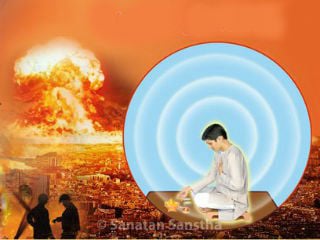Dr. Pramod Moghe is a retired senior scientist from National Chemical Laboratories in Pune. He performed experiments of agnihotra in Pune. Given further are inferences and effects of these experiments in his own words.

1. Effects of an agnihotra
To study the effects of an agnihotra I specially chose an area with high environmental pollution that is the Ramanbag High School, Shaniwar Peth . To study the effects of agnihotra the following parameters were considered.
A. Changes in light and heat levels due to an agnihotra
B. Effects of agnihotra smoke on microorganisms in the environment
C. Effects of agnihotra smoke on the air pollution in the environment
D. Effects of the agnihotra smoke and ash on growth of plants/saplings
E. Medicinal properties of the agnihotra ash
F. Agnihotra ash in keeping water pure.
These experiments were performed in school classrooms. Students, teachers and headmaster of the schools participated in them wholeheartedly thus extending their support to it. Professor of Biotechnology from Fergusson College and professors from the laboratory of Savitribai Phule University in Pune assisted in this experiment. Funding of the project was done by FROST organisation of the Pradnya Vikas Manch. Using all modern scientific equipment, the following benefits of agnihotra enumerated below were successfully presented to the world.
1 A. Cessation of multiplication of 90% microorganisms
The light energy emanating from the agnihotra was measured with the help of a lux meter. To study the effect of Agnihotra smoke on the surrounding organisms, the quantity of organisms in the surrounding environment were measured before and after the agnihotra experiment. It was proved that the multiplication of nearly 90% of microorganisms was stopped by this smoke. As the area selected for the ritual was one with traffic congestion it had a high level of pollution. However, after the ritual the proportion of sulphur dioxide in the atmpsohere was reduced tenfold. This proved the ability of agnihotra to curb pollution.
1 B. Rapid growth of saplings
To study the effects of agnihotra on growth of saplings some sprouted seeds were placed in a room where agnihotra was performed and some outside the school. Seeds smeared with ash from the agnihotra which were kept in the surroundings of the agnihotra showed rapid growth in comparison with seeds kept elsewhere beyond the influence of the agnihotra. This proves how the ritual of agnihotra is extremely useful in farming.
1 C. Reducing bacteria and salts in water by 80 to 90 %
As agnihotra ash is found to be anti-bacterial, through the experiment, it is extremely useful in treatment of wounds and skin diseases. As it was observed that germs in water and salts are reduced by 80 to 90% by adding agnihotra ash to it so it is also useful in purification of water.
All the above benefits can be derived within just 10 minutes of performing the ritual of agnihotra. So, by spending a mere 3 to 5 rupees a day every household can become pollution and germ free and also be provided with pure drinking water. That ash can also be used in farming. We were able to prove this to the world along with evidence and inferences in the World Science monthly magazines. Thus, we were able to project the ancient science of our forefathers to the world and we are proud of it.
2. 70 countries in the world accept the Bharatiya concept of agnihotra
Earlier using 15 plants prescribed by the Vedas for water purification I have made water as pure as mineral water and even procured a world patent for it. But for that instead of enslaving ourselves to our knowledge it is important to believe in our own culture. During the course of this study Germany, Australia, USA, United Kingdom, France, Poland, Czechoslavakia, Japan, Singapore, Peru, Ecuador, Switzerland, Spain and Canada are among 70 countries who have accepted the Bharatiya concept of agnihotra. In fact, they have started publishing these inferences in different monthly science magazines and have even given new name to the farming based on it as ‘Homa Farming technique’.
3. Bharatiyas do not realise the worth of their culture
Unfortunately Bharatiyas have not realised the value of their ancient sciences of physics, chemistry, geology, mathematics, medicine, aeronautics, metallurgy, civil engineering, sculpture which scientists from other countries have utilised fully and created world patents from them. Our complacent scientists are becoming aware of them now ! They do not believe in our ancient sciences till the same appears from the west when they lap it up as something great. It is indeed sad that they fail to realise the worth of our cultural legacies.

 Corona and effect of Agnihotra
Corona and effect of Agnihotra Scientific research on ‘agnihotra’, a precursor of a yadnya (fire sacrifice)
Scientific research on ‘agnihotra’, a precursor of a yadnya (fire sacrifice) Benefits of Agnihotra
Benefits of Agnihotra Agnihotra : Protection from a nuclear attack
Agnihotra : Protection from a nuclear attack
Add sent option the daily article. To sent via telegram…
Namaskar,
Thank you for your valuable suggestion. We have added the option to share articles to Telegram.
Sir
Its good article..
From the schooling we need to give information and procedures of our indian culture in scientific manner..
How its useful for us and nature.
Schools like DAV public school conduct such type of havan in the school …
Extremely valuable research. This is needed to convince persons with scientific temperament.
Thanks a lot. All The Best.
P H Bhanage
I want to use these & related practices on a new farm at Pandharpur. Area presently under cultivation about 100 acres. Please advise how this can be done.
Namaskar,
This article is a research article of Dr Pramod Moghe. It was published on hindi.indiawaterportal.org Since it is a useful article, we have uploaded it for our readers.
For more valuable information on farming, you can refer the below link :
https://www.sanatan.org/mr/a/category/survive-during-the-adverse-times/survival-guide/vegetable-garden
(Pl Note : The information on this link is in Marathi.)